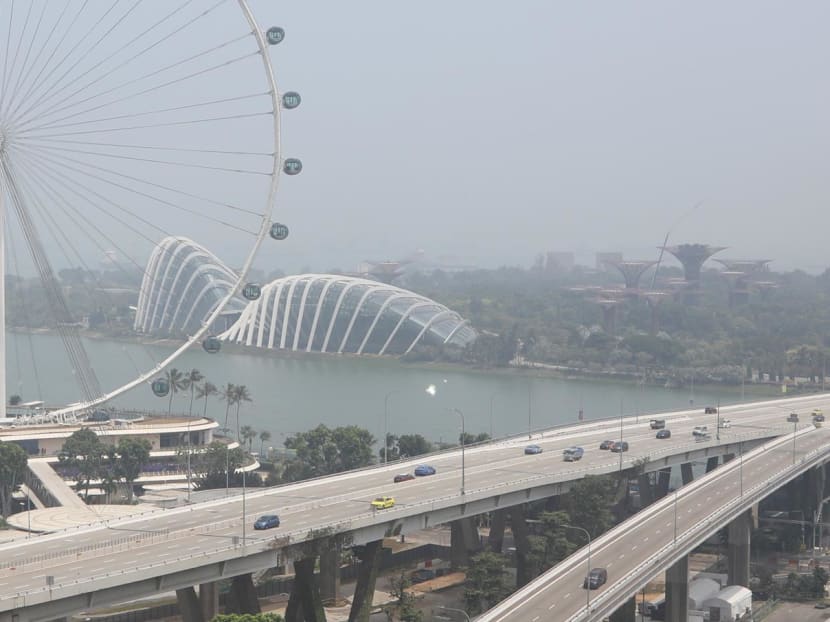Singapore coordinating action plans amid higher haze risk
SINGAPORE — The government’s Inter-Agency Haze Task Force (HTF) is coordinating action plans in preparation for possible haze, the Meteorological Service Singapore (Met Service) said on Tuesday (May 30).
SINGAPORE — The Government’s Inter-Agency Haze Task Force is coordinating action plans in preparation for possible haze, the Meteorological Service Singapore (Met Service) said on Tuesday (May 30).
This is in anticipation of the onset of drier and warmer weather, with the Met Service forecasting El Nino conditions to develop in the second half of 2023.
In addition to El Nino conditions, a positive Indian Ocean Dipole (IOD) is also predicted to develop during this period.
Both climate phenomena are expected to bring warmer and drier conditions to Singapore and the surrounding region from June to October this year, the Met Service said, adding that this will increase the risk of transboundary haze affecting Singapore and the region.
“Members of the public are also advised to make preparations such as ensuring that they have sufficient N95 face masks and air purifiers in good working condition,” the national authority on weather and climate said.

El NINO AND INDIAN OCEAN DIPOLE
According to the Met Service, El Nino is a naturally occurring climate pattern associated with changes in both the ocean and atmosphere in the equatorial Pacific Ocean, including an abnormal warming of the surface waters in the eastern equatorial Pacific.
Typically lasting nine to 12 months and occurring every three to five years, it produces widespread and at times severe changes in the global climate.
The Indian Ocean Dipole (IOD) is similar to the El Nino but occurs in the equatorial Indian Ocean and of shorter duration, typically ending by December to January. The IOD varies between three phases — positive, negative and neutral.
Most computer models from global climate centres predict that a positive IOD may develop in the next one to two months.
During positive IOD events, sea surface temperatures in the eastern Indian Ocean are cooler, resulting in less cloud formation and below average rainfall in the eastern Indian Ocean and surrounding regions including Sumatra, Peninsular Malaysia and Singapore.
MORE INTENSE DRY SEASON
The Met Service said that there is a 70 per cent to 80 per cent chance of an El Nino event occurring this year.
“There are already signs since earlier this year that support El Nino conditions developing in the next few months. These include the warmer subsurface ocean temperatures observed in the eastern tropical Pacific, typically a precursor to El Nino events.”
El Nino events tend to have the biggest influence on Singapore’s rainfall during the southwest monsoon season from June to September, with rainfall up to 45 per cent below average.
The southwest monsoon period between June and September is the usual dry season for Singapore and the surrounding region.
With an expected El Nino and positive IOD, the Met Service said the dry season this year could be more "intense and prolonged" compared to recent years, and extend into October.
“Drier and warmer conditions are conducive to the development of peatland and vegetation fires. Therefore, hotspots could escalate from June 2023 under extended periods of drier weather, particularly in fire-prone areas.
“This will increase the risk of transboundary haze affecting Singapore if fires develop in close proximity and prevailing south-easterly to south-westerly winds blow smoke haze from the fires towards Singapore,” it added.
WARMER TEMPERATURES
During the last strong El Nino event from 2015 to 2016, Singapore’s total rainfall from June to September 2015 was about 35 per cent below the long-term average, said the Met Service.
El Nino events also bring warmer temperatures to Singapore, with the warmest temperatures often occurring when El Nino events weaken typically in March to April the year following the start of the event.
Singapore’s average temperature over the June to September 2015 period was 28.8°C or 0.6°C above its long-term average for that period.
For the period from March to April 2016, Singapore's average temperature was 29.2°C or 1.2°C above its long-term average for that period, said the authority, adding that 2016, together with 2019, are Singapore’s hottest years on record.
“At this stage, there is no indication of the strength and duration of the El Nino, if it develops. Should a strong El Nino set in, well below average rainfall and warmer temperatures can be expected during the coming southwest monsoon season.”
The Met Service said it will continue to closely monitor the development of El Nino and IOD as well as the regional weather and haze situation, and provide updates when necessary. Haze and El Nino updates are available on its website. CNA
For more reports like this, visit cna.asia.










